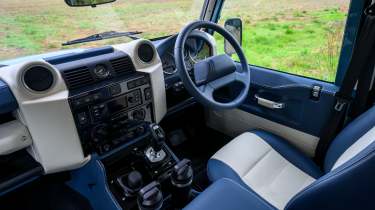Land Rover Classic Defender V8 2024 review – driving a £190,000 Land Rover
Whoever thought that the old Land Rover Defender would join the world of supercars as a way to dispense with a quarter of a million pounds?
The most cultlike fans of the original Land Rover Defender will tell you Land Rover would rather forget it ever existed, now the modern one has taken over. The reality is quite to the contrary, in that Land Rover won’t let the original die. In spite of all the legislative and economic challenges that caused it to close the book on the original back in 2016, it continues to work on special projects using existing cars as a basis, working around the rules that mean they can no longer be built brand new.
The latest, is the Classic Defender V8 by Works Bespoke and, in a good few ways beyond the c£190,000 (plus tax) price of entry, this is a Defender quite unlike the foundational machines that were put to work farming, in our emergency services and in our military over the course of more than seven decades. In quite a few others, in these new specials, the old muckers are alive and well…
> Range Rover Sport SV 2024 review – the new king of SUVs?
What is the Classic Defender V8 by Works Bespoke? Well, it’s in all ways but the number stamped on its brand new chassis plate, a totally new car. Pay JLR Classic upwards of £190,000 and they’ll buy an as close to perfect as possible 2012-2016 Defender and harvest it for its vehicle identification number alone. It’ll then build a totally new (old) Defender, to your exact specification, around that number – chassis included. It’s so much like a new car, it even has a configurator. Any colour, any interior trims (within the realms of legality and reason) – the world is your oyster.
More reviews
In-depth reviews
Long term tests
Reviews
- Land Rover Defender Octa 2025 review – so much more than a ‘Defender SV’
- Land Rover Defender 130 V8 2024 review – an exercise in excess
- Bowler Defender 2023 review
- Bowler Defender Challenge 2022 review – the ultimate off-road toy?
- Land Rover Defender V8 2021 review – a G63 rival, or something more subtle?
- Land Rover Defender 90 X P400 2020 review – heart over head
As the name suggests, they’re all V8s, the Classic Defender V8 being the only ‘new’ car the Jaguar AJ V8 is survived by. Canted down rearwards in the engine bay, the 410bhp 379lb ft V8 feeds a ZF eight-speed automatic transmission, whose shift lever provides by far the most modern part of the Defender’s cabin, almost to the point of being jarring. Performance is by any measure brisk but in a Defender, positively terrifying, with 0-62mph coming up in 5.9sec in the fastest, lightest 90. That rises to 6.1sec in the longer, heavier, more-door 110.
Happily, it’s not a case of dumping the V8 in and letting it loose. The Classic Defender V8 has upgraded four-piston brakes with 335mm and 300mm front and rear discs to slow it down. The suspension is also revised with Eibach springs and anti-roll bars working with Bilstein dampers. The steering box has had to be changed too, so that the V8 will fit, with the P38 Range Rover box it now uses mounted on the outside of the chassis rail rather than the inside. The mechanical spec is, really, a carryover from the Islay Edition and Trophys that came before this. It’s that customisability mentioned above, the Works Bespoke bit, that’s new.
The variety of what can be achieved is articulated perfectly in the test cars JLR Classic provided for us. The first, a Marine Blue car with a Limestone roof, apes the rugged, workmanlike Defender we all know, with the heritage grille, steel wheels, silver bumper, classic seats, Heritage lighting and expedition cage. Inside, there’s plenty of leather all around, in Liberty blue and Perlino.
The other 110 goes all the way in a different direction, with what JLR Classic calls a more ‘urban’ look. It features an adventure grille, the exterior ‘black’ pack, 18-inch sawtooth alloy wheels, modern look LED lights and on the inside, Recaro CS bucket seats. Finally, the 90 could be a prop from a Jurassic Park film with a truly striking Caraway tan leather interior. It features much of the more rugged design spec of the blue car, albeit on the shorter wheelbase body. It’s the latter two cars, the ‘urban’ 110 and the Balmoral Green 90, that we drove to get the best possible feel of the variety on offer.
More than ever in 2024 it remains a totally alien driving experience. And there is value in that. It may have been for a makeover and come back with a fake tan, a new set of pearly whites, and rippling abs but it still knows how to muck out the pigs. It’s still the gruff old farmer you know and love in terms of the driving experience, albeit with some of the rough edges rounded off. Assuming anything else to be the case wouldn’t just be unwise, it’d be borderline dangerous. Try to drive it like you know a modern Range Rover will permit you and you’ll be in trouble.
Especially with all that V8 potency now there under your right boot. Even with the new brakes, suspension and revised steering, you need to be thinking ahead of every input. This Defender is still totally dead in terms of steering response, for at least an eighth of a turn either side of centre. The obvious consequence is judging how you go about cornering but high speed stability is an issue too. A bit in the 110 but especially in the 90, you find yourself sawing at the wheel, or finding yourself settled at over an eighth of a turn one way or the other, just to keep the Defender tracking straight and true, especially on a furrowed A or B road.
This Defender still leans in a way that will very publicly punish you for pushing the limits. You still need to do things the Defender way – anticipate any need to slow and ease into the brakes, anticipate a change of direction and feed in the steering linearly but decisively. The Defender isn’t now and never was, a car that rewards shyness or jerkiness. The ride is marginally improved thanks to the new suspension – opt for the smaller steel wheels for the best possible comfort – but those beam axles still judder and bounce underneath you.
Once you’re up to speed with it, you can start having fun. Ladling out slugs of V8 wallop induces maniacal laughter, as the blunderbus lunges forward, the cabin filled with the sound of bustling rotational mass rather than outright exhaust or induction howl. The incongruous gear shifter has a manual option that’s happily arranged the correct, rally spec way. Pull back for a gear up, push forward for a gear down. The mapping in auto mode is good and adds to the refinement, but there’s no denying the fun you can have.
Set it to a cruise and you notice it’s noticeably quieter inside, to the point that conversations are possible with normal voices at motorway speeds, rather than best carried out through intercom. We were told an NVH pack is being explored based on customer requests, if not currently deployed, meaning future builds could be even more refined. Refined of course, is a relative term... Look around you and while in shape everything in the cabin is still ‘old Defender’, it’s been glazed in swathes of soft touch leather. It’s still not a vehicle most humans will fit in with ease. The driver for instance will always find their outside arm has nowhere to go, pressed as you are up against the door, which has thicker, leatherbound door cards.
A few buttons carry over on the dash but in the 90 we drove, the door’s grab handles were the glorious aluminium anodised items. The high quality feel isn’t everywhere, mind. The Defender’s trim tolerances are the same as ever before, so throw all that leather in and you get a good amount of squeaking on most roads at most speeds. We’d forego the Recaro seats in the ‘urban’ car for the less incongruous premium chairs we sampled in the 90.
Let’s be real, here. By any objective measure, let alone the sensibilities common to the pages of evo, the Defender is as it always was, more a piece of agricultural equipment than the kind of motorcar we’ve become accustomed to over the last few decades. It’s just not good. But it is hilarious, life affirming, charming. It’s a car that will make obvious to even the greatest of Defender detractors, exactly why so many love them so deeply. We like the kinds of cars that cultivate that level of dedication and passion.
And precisely no one has expected anything different from the Works Bespoke Classic V8, including those who are taking the £200k+ plunge. They were always going to buy it and nothing we or anyone else had to say was ever going to change that. Power to them, I hope they get a new Defender OCTA to match.
Price and rivals
As above, the Classic Defender V8 starts from £190,000 for the 90, before VAT, or £199,000 for the 110. The cars we drove range from £243,836.12 on the road for the 90, to £262,540.87 for the ‘Urban’ 110. Given what it is, what it does, obvious rivals are in short supply. A Mercedes-AMG G63 is cut from distantly similar cloth but, in this company, doesn’t have anything like the same sense of humour. The same with the Ineos Grenadier – all of the compromise, none of the joy, very little of the authenticity. Similar guffaw-inducing oldschool, bespoke British built silliness is still available across the range over at Morgan. Our money would likely sooner go on a nicely specced Porsche 911 GT3 RS but then, you already knew that.







